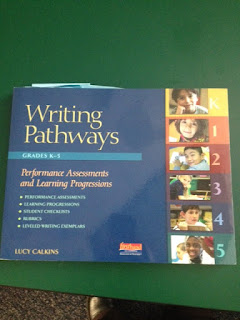Next, we decided to spend our time norming their narrative on-demand assessments they gave the first month of school. The reading team copied off the rubrics and then asked the teachers for 2 pieces of writing each for below, on, and above grade level. We took off the names and made copies for all involved.
We began the meeting by talking about the importance of norming. I used the information in the Writing Pathways book from Units of Study for Writing to guide our discussion.
- Why we norm: The purpose of a norming meeting is to establish consistent and shared expectations across the school for student writing. We align our group as we engage ourselves in close, evidence-based reading.
- What is the process: Four steps below
- What happens when we disagree: Expect and embrace conflict. Conflict is evidence that there is disconnect in the way your view student work, and digging into that disconnect will help you to align your vision.
- If some consensus is not possible, a half-point is an acceptable difference of opinion. Generally if 10 minutes of discussion doesn’t yield something close to consensus, the piece is set aside as a “fence sitter.” Don’t let that one piece derail the whole activity.
Questions to consider:
Work as a group to score 1 student’s piece of writing to reach consensus – where does the student fall?
Where does the student fall on the learning progression and in relation to grade level?
Steps in a Norming Meeting:
Step 1.Work as a group to score 1 students piece of writing to reach consensus – where does the student fall?
- Read through the piece one time
- Then inch through the rubric to assess each item, be careful to note which traits have double the points
Step 2:Score a few other students, then everyone score individually, and come together: What score did we give them?
- If after doing this work with 5 papers of different levels, the group finds that it can come to a consensus, the group can consider itself normed and people can now score papers individually
Step 3: Assess your own students’ writing individually
Step 4: Devise a plan for analyzing on-demand writing across each grade
- will you just look at a few above, at and below
- maybe you will decide just to focus on a few traits that are especially important in the upcoming unit
- maybe you will decide that this scoring process is so valuable that you will continue this work with every on-demand assessment
When making assessment decisions, we need to ask: What are you actually trying to get out of this?
The Payoff: A school culture in which learning progressions, benchmark pieces, and rubrics help teachers work with each other and with their students to accelerate progress.
We definitely needed more than the 40 minute staff meeting to complete the norming process, as we really only got through step 1. However, this is the first time our staff has been asked to complete this type of work and it was great to hear the conversations around writing occuring.





No comments:
Post a Comment